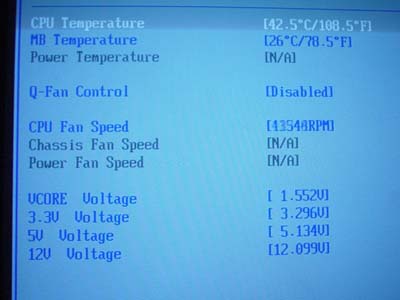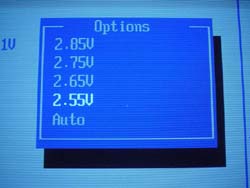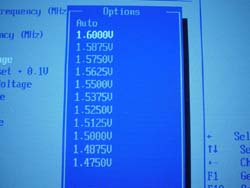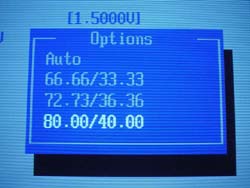ASUS P4C800 Deluxe: BIOS and Overclocking
This time around ASUS decides to go with the well known AMI BIOS setup. In fact, we noticed this particular BIOS setup was reminiscent of Intel's D845PEBT2 BIOS setup.
The P4C800 Deluxe's Hardware Monitor section contains a fairly abundant array of readings and options. The first few readings are of CPU, Motherboard, and Power temperatures, three separate fan speed readings (CPU, Chassis, and Power), Vcore and finally the PSU readings (all rails). In addition, we see that ASUS includes a "Q-Fan Control" option in this section to regulate CPU fan speed depending on exactly what task your system is performing. Within Q-Fan are ratio options that regulate exactly how slow or fast you want your CPU fan to spin; these ratios range from 0/16 to 15/16. The default ratio is 11/16. We decided to see exactly how effective this option would be with the ratio set to 5/16. At this ratio we found that, in general, the CPU fan was noticeably quieter, though this was with the system laid out on a lab table and not inside an ATX case where the noise level would have made less difference. We will be conducting noise tests on various components in the near future.
In the Chipset section there is the usual list of DRAM timing options available for tweaking system performance. These include CAS Latency, Precharge to Active, Active to Precharge, Active to CMD, and Memory Acceleration mode. That last option is new to us (and probably related to the 875P chipset itself), but leaving it on the default "Auto" setting is the fastest performance you're going to get out of this option. As usual we set the other DRAM timings to CAS 2/2T/5T/2T, and experienced no issues as you will soon see in the Stress Testing section of this review.
The memory frequency options available in the Jumperfree Configuration section include only dual DDR266 and dual DDR333 options using a 533MHz FSB processor. With an 800MHz FSB processor your memory frequency options include one higher frequency, dual DDR400 frequency. These most definitely aren't the most abundant memory frequency options we've ever seen, but they're quite acceptable for average desktop users. What's nice about these options, though, is that overclockers will be able to get well over 200MHz FSB while not being limited by too high a memory speed. In other words, you can run at 200MHz FSB with your memory set to dual DDR266 mode and not have to worry about your memory maxing out for quite some time.
One of the more important BIOS overclocking options available is the FSB adjustments, which are available in 1MHz increments all the way up to 300MHz FSB. This is unnecessarily high, but nice to have even if you won't ever be able to fully take advantage of a 300MHz FSB as long as there isn't an official memory spec beyond DDR400. We explain some basic fundamentals to understanding FSB frequency and its relationship to memory frequency in the FSB overclocking section.
There are several VDIMM control options to choose from within the Jumperfree Configuration section of the P4C800 Deluxe BIOS. In total, VDIMM is adjustable as high as 2.85V in 0.1V increments, with the default value being 2.55V. Memory performance fanatics will be very pleased with these options, while your average desktop enthusiast will simply be mildly happy that they have wide flexibility to adjust VDIMM.
ASUS was kind to all those crazy overvolters out there and decided to include VAGP adjustments in 0.1V increments as high as 1.8V. This has little meaning to the average desktop user but can be very useful for the overclockers and enthusiasts out there that like to really take things to the max.
The Vcore adjustments available in the P4C800 Deluxe's BIOS aren't all that stellar from an overclocker's point of view, but perfectly acceptable from anyone else's point of view. Vcore is adjustable as high as 1.60V in 0.0125V increments, and while overclockers might be put off by this they'll at least be pleased to know that, as per tradition, ASUS overvolts Vcore between 0.052-0.058V, meaning if you had a 1.50V processor set to default voltage in the P4C800 Deluxe, it would actually be running between 1.552V and 1.558V. So in the end, actual Vcore can reach as high as 1.658V, sometimes dipping as low as 1.652V when the value "1.6V" is saved to CMOS.
There is a very useful AGP/PCI lock present in the P4C800 Deluxe's BIOS under the Jumperfree Configuration section. Knowledgeable users know that 99% of all Intel chipset-based motherboards come with this AGP/PCI lock, so this will be no surprise to them. This is a critical feature to modders and overclockers out there, so don't worry you're getting everything you've asked for.















0 Comments
View All Comments